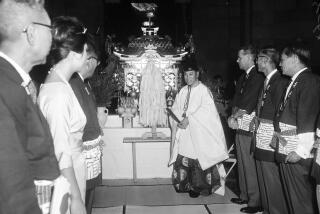Everyone’s a critic: Was it a political...
Everyone’s a critic: Was it a political act? Or mere theft? All that’s certain is that the three crabs that form part of Robert Graham’s new sculpture, “Source Figure,” disappeared Tuesday night. And it’s doubtful that they scuttled off on their own.
The crustaceans had caused some puzzlement, if not controversy, during their brief stay atop the Bunker Hill Steps. They decorated the base of Graham’s likeness of a nude woman of African heritage.
One Bunker Hill executive said that the consensus of his colleagues was that “the crabs were pretty silly--an incongruity. Where did they come from--a sale at a 99 Only store?”
A writer in the L.A. Downtown News went so far as to condemn the crabs as “a slap in the face” of black women.
A spokeswoman for Maguire Thomas Partners, which developed the Bunker Hills Steps, said: “They (the crabs) were very heavy and were welded to the pillar. They (the thieves) must have had unbelievable tools.”
Hopefully not giant sets of crab-crackers.
List of the day: Graham’s “Source Figure” is one of many local sculptures that have stirred up controversy over the years. Some others:
1. “The New World” (1991), depictions of an anatomically correct female and baby by Tom Otterness outside the new downtown federal building. The figures, termed “obscene” by one judge, were removed, then reinstated behind a protective railing.
2. “Olympic Gateway” (1984), Graham’s nudes of a male and female athlete outside the Coliseum. They’re missing their heads, which is how he designed them. Some critics wondered if it was a comment on the intelligence of athletes.
3. David Hockney’s untitled design (1987) of the floor of the swimming pool at Hollywood’s Roosevelt Hotel. Health officials said the design would block lifeguards’ view of swimmers but later allowed it to remain.
4. “The Triforium” (1975), a giant music box near City Hall that somewhat resembles three six-story tuning forks clad in garish costume jewelry. Noting its cost to taxpayers, critics nicknamed artist Joseph Young’s work the “Million-Dollar Jukebox.”
5. “Back Seat Dodge ‘38” (1966), Edward Kienholz’s lusty, beer-bottle-festooned work of a couple making whoopee in a car, which some politicians tried to ban after its debut at the County Museum of Art.
6. “Family Group” (1955) by Bernard Rosenthal, a sculpture of a faceless man, woman and child at Parker Center. One councilman complained: “No eyes, no nose, no ears. Whoever designed this must have a low opinion of the American family.”
No, you can’t take the sofa: County Administrative Officer Richard Dixon has resigned amid allegations that, among other things, he wasted taxpayers’ money on a redecorating project. His replacement won’t have an easy job. But one thing is certain: The new CAO sure will have a nice office.
miscelLAny:
Today is the 104th anniversary of the birth of Raymond Chandler, L.A.’s literary lion. So, how about a chorus of “Happy Birthday” on behalf of the city he celebrated as “rich and vigorous and full of pride, a city lost and beaten and full of emptiness.” Also, one chorus of “I Love L.A.”
More to Read
The biggest entertainment stories
Get our big stories about Hollywood, film, television, music, arts, culture and more right in your inbox as soon as they publish.
You may occasionally receive promotional content from the Los Angeles Times.










